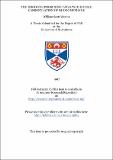The rhodium/phosphine catalysed double carbonylation of diiodomethane
Abstract
The use of the catalyst precursors rhodium acetate [Rh₂(OAc)₄], carbon monoxide and triethyl phosphine in an alcoholic solvent forms a catalytic species capable of the double carbonylation of diiodomethane. When this reaction is carried out in ethanol, the major products are diethylmalonate (DEM) and ethyl iodide.
CH₂l₂ + 2CO + 2EtOH □(→┴([Rh^2(OAc)4 ]/ PEt₃/CO ) ) CH₂(COOEt)₂ +2Hl
The ethyl iodide is formed by the reaction of EtOH with HI, presumably forming equal amounts of water. The other, minor, products of this reaction were diethoxymethane (CH₂(OEt)₂), ethyl propanoate (CH₃CO₂Et) with a trace of ethyl acetate (CH3CO₂Et). The diethoxymethane is formed by the ethanolysis of the substrate and the ethyl propanoate may be from the carbonylation of ethyl iodide formed in situ. The source of the ethyl acetate has been shown to be ketene, a metal complex thereof being shown to be the singly carbonylated intermediate between diiodomethane and DEM. Possibly the most notable feature of this catalytic reaction is that it occurs in the absence of added base. A review of all the double carbonylation reactions reported to date reveals this catalytic system to be unique in this respect (see chapter one). It is the solvent, EtOH, which acts as the sink for HI in this system and this accounts for the high yields of EtI. A thorough study of the mechanism of this reaction has led to the proposal of the mechanistic cycle shown in figure A. The most salient feature of this mechanism is the proposal of a metallo ketene intermediate. Evidence for the involvement of a metallo ketene complex in this reaction comes from the study of the attempted synthesis of the iodoacyl intermediate 3d and a deuterium labelling study (chapter three).
Type
Thesis, PhD Doctor of Philosophy
Collections
Items in the St Andrews Research Repository are protected by copyright, with all rights reserved, unless otherwise indicated.

